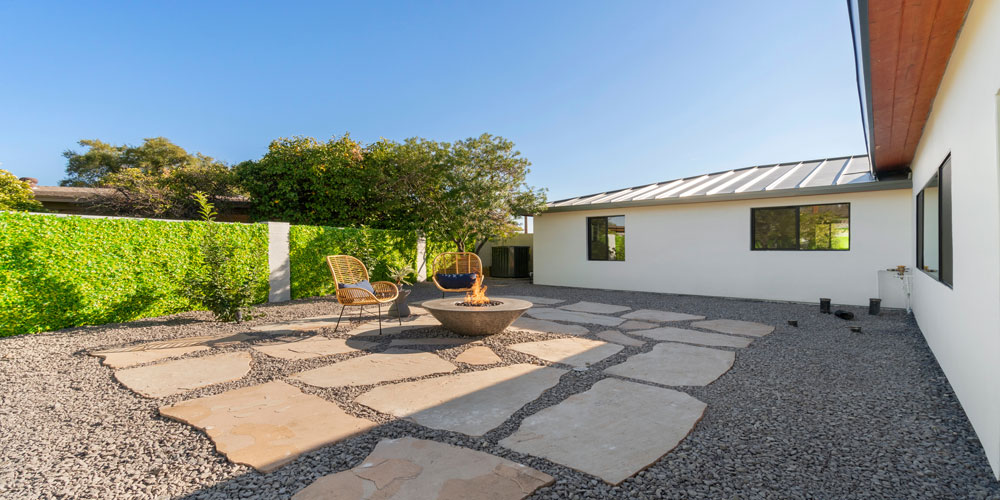A New Patio & Your Property
A well-designed patio can transform your outdoor space, making it more functional, aesthetically pleasing, and valuable. Whether you enjoy hosting gatherings, desire a quiet place to relax, or want to boost your property’s resale value, a new patio can be a fantastic addition to your home. This post will guide you through the benefits of installing a patio, various design considerations, material choices, and maintenance tips to ensure your new patio remains a cherished part of your property for years to come.
Benefits of Adding a Patio
Enhanced Aesthetic Appeal
A new patio can significantly enhance the visual appeal of your property. With a variety of designs and materials to choose from, you can create an outdoor space that complements your home’s architecture and landscaping. Whether you opt for a classic stone patio or a modern, minimalist design, the addition can provide a seamless transition from indoors to outdoors, making your property more inviting and cohesive.
Increased Property Value
Adding a patio is a wise investment. Outdoor living spaces are highly desirable features that can boost your property’s market value. According to real estate experts, a well-designed patio can provide a return on investment (ROI) of up to 80%. Homebuyers often look for properties with attractive outdoor spaces, and a new patio can set your home apart from the competition.
Extended Living Space
A patio effectively extends your living space, offering a versatile area for various activities. From outdoor dining and entertaining to a serene spot for reading or meditating, a patio can serve multiple purposes. It allows you to enjoy the fresh air and sunshine while still being within the comfort of your home environment.
Low Maintenance
Compared to other outdoor features like lawns and gardens, patios require relatively low maintenance. With the right materials and design, you can have a durable and easy-to-clean space. This means you can spend more time enjoying your patio and less time worrying about upkeep.
Design Considerations
When planning your new patio, several design considerations can help you create a space that is both functional and beautiful.
Location
The location of your patio is crucial. Consider factors such as sunlight, wind, privacy, and accessibility when choosing the best spot. For instance, a patio located adjacent to the kitchen can be convenient for outdoor dining, while a more secluded area might be ideal for a private retreat.
Size and Shape
The size and shape of your patio should align with its intended use and the overall layout of your property. A small, intimate patio may be perfect for a cozy seating area, while a larger space can accommodate dining tables, lounge chairs, and other furniture. Curved or angular shapes can add visual interest and help define different zones within the patio.
Integration with Landscaping
Integrating your patio with the surrounding landscaping can create a harmonious and natural look. Consider using plants, trees, and garden beds to soften the edges of your patio and blend it with the environment. You can also incorporate elements like water features, fire pits, or outdoor lighting to enhance the ambiance and functionality.
Style and Theme
Choose a style and theme that complements your home and personal preferences. Whether you prefer a rustic, Mediterranean, modern, or traditional look, your patio design should reflect your taste and enhance the overall aesthetic of your property. Pay attention to details like color schemes, textures, and patterns to create a cohesive and visually appealing space.
Material Choices
Selecting the right materials is essential for creating a durable and attractive patio. Here are some popular options to consider:
Concrete
Concrete is a versatile and cost-effective material that can be molded into various shapes and designs. It can be stamped, stained, or textured to mimic the appearance of stone, brick, or tile. Concrete patios are durable, low-maintenance, and suitable for various climates.
Natural Stone
Natural stone, such as flagstone, slate, or bluestone, offers a timeless and elegant look. Each stone has unique colors and patterns, adding a natural charm to your patio. While natural stone can be more expensive than other materials, its durability and aesthetic appeal make it a worthwhile investment.
Brick
Brick patios have a classic and traditional appeal. They are available in various colors and can be arranged in different patterns, such as herringbone or basket weave. Brick is a durable and low-maintenance material, but it may require occasional re-sanding or resealing.
Pavers
Pavers are precast concrete, brick, or stone units that come in various shapes, sizes, and colors. They offer flexibility in design and are relatively easy to install and replace. Pavers are durable and can withstand heavy foot traffic and weather conditions.
Gravel
Gravel is an affordable and easy-to-install option for a casual and informal patio. It provides good drainage and can be combined with other materials like stepping stones or pavers. However, gravel may require occasional raking and replenishing to maintain its appearance.
Installation Process
Installing a new patio involves several steps, from planning and preparation to construction and finishing touches. Here’s an overview of the process:
Planning and Design
Start by sketching your patio design and determining its dimensions. Consider factors like the layout, materials, and any additional features you want to include. It’s also essential to check local building codes and regulations to ensure compliance.
Site Preparation
Prepare the site by clearing any vegetation, debris, or existing structures. Mark the boundaries of your patio and excavate the area to a suitable depth, typically 6-8 inches, to accommodate the base materials and patio surface.
Base Layer
A stable and well-compacted base is crucial for a durable patio. Start with a layer of crushed stone or gravel, which provides good drainage and prevents shifting. Compact the base material thoroughly using a plate compactor.
Installation of Patio Surface
Lay the chosen patio material according to your design plan. For pavers, bricks, or stones, start from one corner and work your way across, ensuring even spacing and alignment. For concrete, pour and spread the mixture evenly, then use a trowel or stamping tools to achieve the desired finish.
Finishing Touches
Once the patio surface is in place, add finishing touches like edging, joint sand, or sealant to enhance durability and appearance. You can also incorporate landscaping elements, furniture, and decorative accessories to complete the look.
Maintenance Tips
Proper maintenance is essential to keep your patio looking great and functioning well over time. Here are some tips to help you maintain your new patio:
Regular Cleaning
Sweep your patio regularly to remove dirt, leaves, and debris. For more thorough cleaning, use a garden hose or pressure washer to wash away grime and stains. Avoid using harsh chemicals that can damage the patio material.
Sealing
Applying a sealant can protect your patio from moisture, stains, and UV damage. Sealants should be reapplied periodically, depending on the material and exposure to the elements. Follow the manufacturer’s recommendations for the best results.
Weed Control
Prevent weeds from growing between pavers or stones by using polymeric sand or a weed barrier fabric during installation. Regularly inspect and remove any weeds that do appear to maintain a clean and tidy patio.
Repair and Maintenance
Address any cracks, chips, or loose elements promptly to prevent further damage. For pavers or bricks, you can easily replace individual units if needed. For concrete or stone patios, consider professional repair services for significant issues.
Seasonal Care
In colder climates, protect your patio from freeze-thaw cycles by avoiding the use of de-icing salts and using a snow shovel or broom to remove snow. In warmer climates, provide shade or use patio covers to prevent excessive heat and sun damage.
A New Patio & Your Property
A new patio can be a valuable addition to your property, offering aesthetic, functional, and financial benefits. By carefully planning your patio design, choosing the right materials, and following proper installation and maintenance practices, you can create an outdoor space that enhances your lifestyle and adds lasting value to your home. Whether you envision a tranquil retreat, an entertainment hub, or a versatile outdoor living area, a new patio can turn your vision into reality and elevate your property’s appeal.



